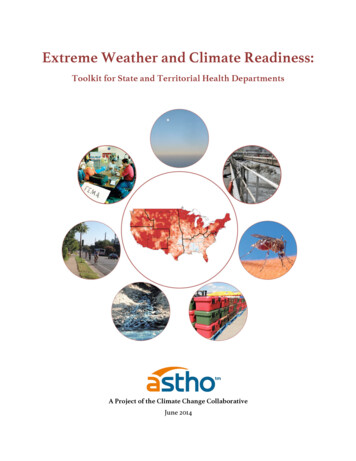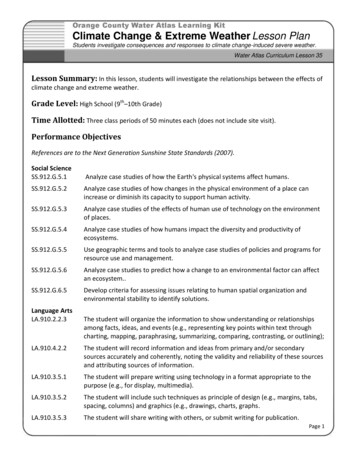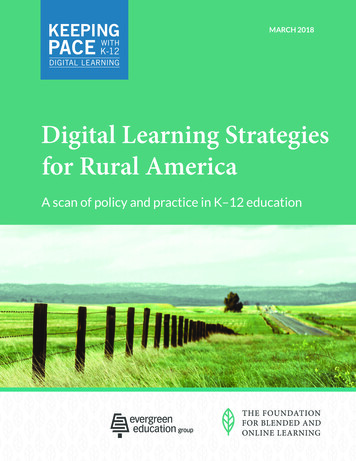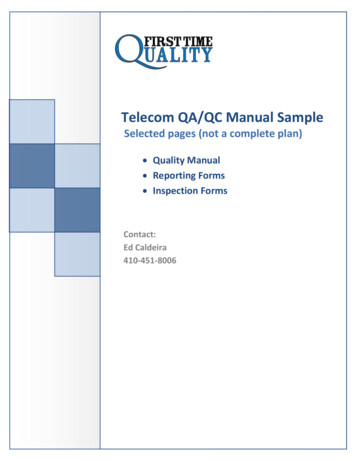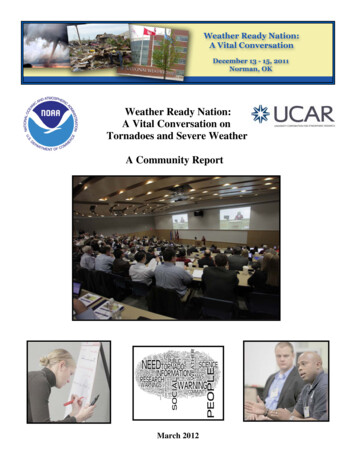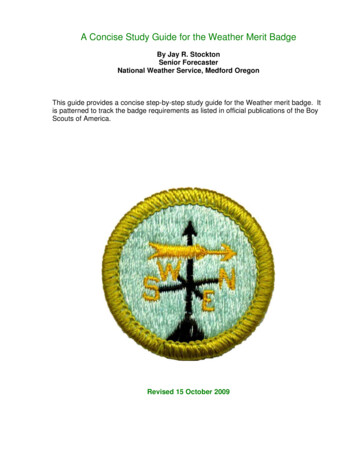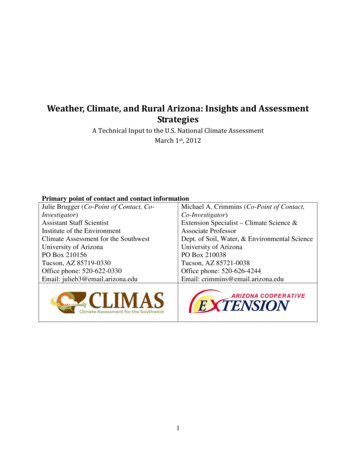
Transcription
Weather, Climate, and Rural Arizona: Insights and AssessmentStrategiesA Technical Input to the U.S. National Climate AssessmentMarch 1st, 2012Primary point of contact and contact informationJulie Brugger (Co-Point of Contact, CoMichael A. Crimmins (Co-Point of Contact,Investigator)Co-Investigator)Assistant Staff ScientistExtension Specialist – Climate Science &Institute of the EnvironmentAssociate ProfessorClimate Assessment for the SouthwestDept. of Soil, Water, & Environmental ScienceUniversity of ArizonaUniversity of ArizonaPO Box 210156PO Box 210038Tucson, AZ 85719-0330Tucson, AZ 85721-0038Office phone: 520-622-0330Office phone: 520-626-4244Email: julieb3@email.arizona.eduEmail: crimmins@email.arizona.edu1
Table of ContentsExecutive Summary . 41. Introduction . 82. Methodology . 113. County Profiles . 164. Results of Group Discussions . 204.1 Perceptions of weather and climate . 214.2 Impacts of weather and climate . 294.3 Adaptation . 364.3.1 “Living with the climate”. 364.3.2 Weather and climate information sources and needs . 384.3.3 Current weather- and climate-related planning. 424.3.4 Local-scale approaches to climate change adaptation . 474.3.5 Challenges to adaptation . 514.3.6 Supporting adaptation in rural communities . 535. Conclusions . 545.1 Results of the case study . 545.2 Utilizing qualitative methods for ongoing assessments . 565.3 The role of Cooperative Extension . 56References . 59Figures. 63Figure 1. Average monthly temperature and precipitation for the state of Arizona . 64Figure 2. Long-term annual average temperature across Arizona depicted using 4km PRISMclimate data . 65Figure 3. Long-term annual average total precipitation across Arizona depicted using 4kmPRISM climate data . 66Figure 4. Meeting locations and major cities across Arizona . 67Figure 5. Land ownership and management jurisdictions across Arizona . 68Figure 6. Land cover and land use across Arizona depicted using the 2006 National LandCover Dataset . 69Figure 7: Word cloud representing most frequently used words in all discussions combined . 70Figure 8: Effect of thinning along Highway 260 in Navajo County. 71Tables . 72Table 1: List of county indicators . 73Table 2: Number of participants by group. . 74Table 3: Discussion group guiding questions and prompts . 75Table 4: Location and climatic conditions where discussions were held . 76Table 5: Socioeconomic indicators by county . 77Table 6: Significant weather and climate events brought up in group discussions . 78Table 7: Word frequencies by county . 79APPENDIX I – Map creation and Data Sources . 802
AcknowledgmentsThis study was funded by the Climate Program Office of the National Oceanographic andAtmospheric Administration (NOAA). We would like to thank the Arizona residents whoparticipated in the group discussions for giving their time, for their lively discussions, and for thetremendous insights into how rural residents understand, respond to, and plan for weather andclimate in their daily lives which they provided. Most especially we would like to thank theCounty Extension Directors and Agents who shared their time and knowledge of their countieswith us and made it possible for these discussions to happen. We are also very appreciative of thelogistical and administrative support provided by University of Arizona Cooperative Extensionadministration and the core office of the Climate Assessment for the Southwest.3
Executive SummaryThis report describes the results of a study by an interdisciplinary team at the ClimateAssessment for the Southwest (CLIMAS), one of 11 Regional Integrated Sciences andAssessments Centers (RISAs) funded by the Climate Program Office of the NationalOceanographic and Atmospheric Administration (NOAA). The goal of the RISA Program is tosupport research that addresses complex climate-sensitive issues of concern to decision-makers,policy-makers, planners, and managers at a regional level. CLIMAS, the RISA for the regionthat includes Arizona and New Mexico, promotes participatory, iterative research involvingscientists, decision makers, resource users, educators, and others who need more and betterinformation about climate and its impacts. This particular study was funded by a 2010 grantfrom NOAA to each RISA to conduct one-year exploratory research projects designed tocontribute to the National Climate Assessment process currently being developed by the U.S.Global Change Research Program. The research took place between February and November2011 and was designed to accomplish two goals: 1) to learn how rural Arizonans understand,plan for, and respond to weather and climate in their daily lives, information that can help federalagencies provide climate-related information and programs that better meet their needs; 2) toassess the role that University of Arizona Cooperative Extension can play in the process ofassessing climate service needs, and providing programs to enhance adaptive capacity.This report is targeted at authors of chapters for the 2013 National Climate Assessment,particularly the chapters on Rural Communities, Adaptation, and the Southwest region, andmembers of the National Climate Assessment Development and Advisory Committee with thegoals of addressing three of the eight topics that are priorities for the 2013 NCA. First, for theEngagement, Communications, and Evaluation topic, the report provides a case study illustratingclimate change-related issues faced by rural residents in Arizona, including privatelandowners/producers (e.g. ranchers and farmers), state and federal natural resource managersand local government and planning officials, at this point in time. The study was designed to useethnographic methods to elicit the perspectives and ideas of rural residents and decision makers,while sidestepping the political sensitivity of the topic of climate change in the U.S. at this time.Second, for the Adaptation topic, the report provides a case study that illustrates how ruralArizona residents approach adaptation, including how they typically respond to and plan forweather-and climate-related events, how they are responding to climate changes they arecurrently experiencing, and their ideas about how to better plan for or respond to climatevariability and change in their communities. Third, for the Sustained Assessments and ResearchNeeds topic, the report identifies a “path forward” for sustaining the assessment activities wehave undertaken by assessing the capacity of University of Arizona Cooperative Extension to bean ongoing partner in the NCA process and to assist in ongoing climate adaptation andmitigation efforts and education at the local level, and by suggesting how, nation-wide,Cooperative Extension could become a partner in the NCA process. The report also provides adetailed description of the research methodology used and the rationale behind it in order tocontribute to the development of an ongoing, consistent, and replicable approach to nationalscale climate assessment which can incorporate the advantages and policy relevance provided byqualitative research, in particular by the traditional ethnographic methods of culturalanthropology.4
The key findings for each of these topics are summarized below.Engagement, Communication, and Evaluation1. Rural Arizonans are highly attuned to weather and climate. Participants in the study displayeda high awareness, not only of current weather and climate conditions, but of past and projectedconditions as well. They were familiar with and used a variety of weather and climateinformation sources, and many have their own rain gauges or weather stations at home.2. Their perceptions of weather and climate are shaped by many factors: among them,geographic location, current weather conditions; recent or remembered extreme weather events;knowledge of conditions in the past; length of residence; and occupation.3. The weather/climate-related topic that emerged as by far most important for rural Arizonans iswater. Among specific weather/climate phenomena, rain is discussed the most, including rainfallseasonality, lack of rain, and changes in rainfall patterns. However, at this time, drought andwildfire are the topics that generate the most concern.4. Short-term drought impacts ranchers more than any other group because of its effects onvegetation and water sources for cattle. Drought also has extreme impact on forest health andfire danger. Farmers’ concern about drought is related to the source of their irrigation water.Many feel they are more impacted by a perceived recent change in climate variability and in thefrequency of extreme events like hot and cold temperature extremes, wind events and shifts ingrowing season length.5. Rural Arizonans are aware of a variety of climate changes, including changes in rainfallpatterns both in time and space, more intense rainfall and localized flooding events, increasedtemperature extremes, an increase in the frequency of extreme wind events and an increase in theintensity, duration and frequency of drought conditions.6. Their attitudes toward climate change attribution vary. A minority of those who participatedin the study accept it fully because of the climate changes they have experienced. Many, havingexperienced the extreme variability of climate in Arizona, or being aware of the politicalsensitivity of the issue of climate change and the policy recommendations associated with it, arehesitant to attribute the changes they are experiencing to human causes. Most would like to learnmore about climate variability and change.Adaptation1. Rural Arizonans seldom use the word “adaptation,” and while they are constantly adjusting tothe arid to semi-arid, highly variable climate of Arizona, they are more likely to think of theiractions as a normal response to living in a variable climate.2. Rural Arizonans are avid consumers of weather and climate information, while remainingskeptical about its accuracy. To improve their weather- and climate-related planning, they would5
like information tailored to their specific area, better local-scale precipitation monitoring, andNational Weather Service websites that are easier to use. More accurate and localized short-termforecasting of extreme weather events would help them plan for events that will immediatelyaffect their daily lives; general intermediate-term climate projections of about ten years wouldhelp farmers and local-level planners make decisions about investing in expensive machinery orinfrastructure; and general longer-term projections would help agricultural producers, resourcemanagers, and local government planners begin thinking about future planning and adaptationpossibilities.3. In addition to weather and climate, ranchers, farmers, resource managers, and local-levelofficials take many factors into account in their planning including such factors as cost of inputs,market prices for their products, availability of water, property taxes, government policies,environmental regulations, and public perceptions. Because decision-making is so complex andinformation about future climate conditions are so uncertain, participants suggested that the bestapproach to integrating climate change into planning would be to address the legacy of pastmaladapative natural resource management and development activities (e.g. forest healthconditions and water resources planning) within the context of a changing climate.4. Participants’ main suggestions for how to adjust to the climate changes they are experiencingfall into two major categories: water conservation and educating people about how to live in theArizona environment (i.e. reducing exposure and vulnerability to Arizona weather and climate).Three less prominent categories include: landscape restoration; local level planning, especiallyfor water and drought, and broader institutional reform that would allow more flexibility at thelocal level.5. Factors that impede local adaptation initiatives include: lack of confidence that climate changeis permanent (i.e. belief that recent changes experienced are part of a natural cycle); lack ofresources; and structural barriers such as environmental regulations, government policies, andtax and rate structures that do not allow for the needed flexibility at the local level. In particular,participants noted the challenges that rural communities, who are a political minority, facehaving their concerns taken into account in national-level legislation and policy that affect rurallandscapes.Sustained Assessments and Research Needs1. By working through University of Arizona Cooperative Extension, a small interdisciplinaryteam was able to accomplish an ethnographic study for the purpose of climate assessment inrural Arizona with minimal resources. The type of information generated is essential to climateassessment and climate adaptation research because it provides insight into how climate changeis experienced and responded to at the individual and local level, through non-economic values,and into similarities and differences between and within counties in the same region that indicatehow they could be impacted unequally by changes in climate and through broad-based policiesaimed at responding to climate change.2. This study indicates that Cooperative Extension, which has existed as a nationwideorganization that connects knowledge developed at state land-grant universities with people who6
can use it since 1914, and maintains a network of university-trained Extension agents in countiesnationwide, is uniquely positioned to extend the National Climate Assessment process andproducts to rural communities. However, the Cooperative Extension System across the countryhas lost much of the regular federal and state funding traditionally relied on for support, so arecommitment to funding and/or exploration of new funding mechanisms is required to sustainthis partnership.7
1. IntroductionThis report describes the results of a study by an interdisciplinary team at the ClimateAssessment for the Southwest (CLIMAS), one of 11 Regional Integrated Sciences andAssessments Centers (RISAs) funded by the Climate Program Office of the NationalOceanographic and Atmospheric Administration (NOAA). The goal of the RISA Program is tosupport research that addresses complex climate-sensitive issues of concern to decision-makers,policy-makers, planners, and managers at a regional level. CLIMAS, the RISA for the regionthat includes Arizona and New Mexico, promotes participatory, iterative research involvingscientists, decision makers, resource users, educators, and others who need more and betterinformation about climate and its impacts. This particular study was funded by a 2010 grantfrom NOAA to each RISA to conduct one-year exploratory research projects designed tocontribute to the National Climate Assessment process currently being developed by the U.S.Global Change Research Program. Dr. Michael Crimmins, Climate Science Extension Specialistand Associate Professor at the University of Arizona, and a CLIMAS Investigator, proposed aqualitative study that would work through University of Arizona Cooperative Extension (UACE)to assess the climate service needs and adaptive capacity of rural residents in each of Arizona’sfifteen counties. Dr. Julie Brugger, an anthropologist with experience working in the ruralAmerican West, was hired to design and carry out the qualitative research. The study wasdesigned to accomplish two goals: 1) to learn how rural Arizonans understand, plan for, andrespond to weather and climate in their daily lives, information that can help federal agenciesprovide climate-related information and programs that better meet their needs; 2) to assess therole that UACE can play in the process of assessing climate service needs, and providingprograms to enhance adaptive capacity.Rural residents are an often overlooked minority in the U.S. 1 The 2010 census showed that onlyabout 17% of the U.S. population lives in rural areas (Lal et al. 2011). In addition, less than 3%of the workforce is involved in primary resource production (McCarthy 2002). Medianhousehold income is less in rural than in urban areas – 40,135 versus 51,522 in 2009 – and thepoverty rate is higher – 16.5% versus 14.9% in 2010 (USDA Economic Research Service). Inthe western U.S., distinguished by a largely arid to semi-arid climate and a high proportion ofpublic land, 2 resource-based rural economies have been declining since the last quarter of thetwentieth century, as a result of decreasing commodity prices, horizontal integrations inagriculture and resource extraction industries, globalization, and reduced trade barriers.Meanwhile, the West’s aesthetic landscapes, vast public lands, and lower real estate prices areattracting more tourists, recreationists, and urban migrants who view the landscape in terms of itsamenity value rather than as ancestral home and a source of livelihood as do many lifetimeresidents. As the rural West shifts from a resource-based production economy to an amenitybased consumption economy, tourism, recreation, and real estate are becoming the main localindustries (Walker 2003). Because the first two typically offer low-paid service employment,1The USDA Economic Research Service uses several different definitions for “rural” in the statistics it provides.For the purposes of this study, we use a vernacular, rather than a technical definition. Rural areas are those that arenot urbanized, have a low population density, and a high proportion of agricultural land, rangeland, or public lands.2The federal government owns 671.8 million acres (29.6%) of the territory of the United States and most of it is inthe West, where over 50% of the land is federally owned (Vincent et al.2004).8
while the latter generates tax increases, longtime rural residents are struggling to make endsmeet. At the same time, increasing numbers of amenity migrants from urban backgrounds,whose worldviews and values differ from those of longtime residents, are challengingestablished community identities. In addition, the media and popular culture, which aredominated by urban worldviews, are likely to represent rural producers as overusing ormismanaging natural resources, and to represent rural residents more generally in demeaningways. Geographers Jarosz and Lawson (2002) argue that the latter “redneck” discourse serves toobscure the increasingly uneven development between rural and urban areas and the sharpeningof class differences it is producing. This is the predicament of many of the people who areproducing the food we eat and managing the natural resources we use.The social, economic, and political challenges already facing rural communities in the AmericanWest are heightened in the Southwest 3 by the fastest growing population in the nation, limitedwater resources, and an arid and highly variable climate. In Arizona population has grown by24% since 2000 (only Nevada’s grew faster), 40% between 1990 and 2000, and 35% the decadebefore that (USDA Economic Research Service). This exceptional population increase isoccurring despite Arizona’s extremely limited water resources. The constraints imposed byaridity have so far been overcome by the development of large-scale, federally-subsidized waterimportation and transport systems and by significant groundwater overdraft (Colby and Jacobs2007). However, there is mounting evidence that these water management systems are runningup against physical, economic, and ecological limits that constrain the expansion of watersupplies, at the same time that climate change threatens current supplies (Gleick 2010; Overpeckand Udall 2010). This situation is made worse by the fact that Arizona continues to have one ofthe highest poverty rates by state in the nation, and the poor are among the most vulnerable towater shortages.The climate of Arizona is exceptionally unique and important to all aspects of life and commercein the state. A seasonal-transitional climate characterized by two distinct wet seasons withintervening dry periods creates exceptional variability in precipitation and temperature levelsthroughout the annual cycle (Figure 1). Winter season rainfall typically comes from large-scalefrontal storms delivering low-intensity precipitation to broad areas. The summer season isdominated by convective rainfall related to monsoon thunderstorm activity. Thesethunderstorms can produce large amounts of rainfall over short periods of time and typically onlyimpact very small spatial areas (Goodrich et al. 1995).Dramatic topographic relief across the state adds to this variability by creating a diverse range ofclimatic regimes governed by elevation-temperature and elevation-precipitation relationships.Higher elevation locations receive on average ten times more precipitation and are tens ofdegrees cooler than the lowest elevation areas of the state (see Figures 2 and 3).Arizona also experiences high levels of interannual precipitation variability related to the ElNiño-Southern Oscillation (ENSO). This periodic shift in sea surface temperature patternsacross the equatorial Pacific Ocean impacts the winter storm track, moving it south towards3Considered here to include California, the Great Basin, and the Colorado River Basin (the states of California,Nevada, Utah, Arizona, and parts of Wyoming, Colorado, and New Mexico) because their arid portions have similarclimate and interdependent hydrological resources (Cayan et al.2010).9
Arizona during El Niño events creating wetter-than-average conditions and northward awayfrom Arizona during La Niña events with drier-than-average conditions. The frequency of ElNiño and La Niña events also varies at decadal scales, producing longer-term pluvial anddrought periods that can also last for decades. Tree-ring reconstructions of precipitationvariability across the Southwest indicate that decadal cycles between droughts and pluvials havedominated the interannual variability in Arizona climate over the past 1000 years (Sheppard etal. 2002). Several distinct periods of climate have impacted Arizona in very diverse ways overjust the last sixty years. A shift towards to more La Niña events and drier winter conditions inthe 1950’s led to widespread drought and impacts to water resources across the state. Asubsequent shift towards more frequent El Niño events in the mid-1970’s led to a very wetperiod that last until the mid-1990’s. During this period, much of Arizona experienced recordwet conditions, several floods of record, and dramatic shifts in vegetation with many newinvasive species taking hold (Crimmins and Comrie 2004). A subtle shift back towards morefrequent La Niña events occurred in the late 1990’s leading to the return of drought conditionssimilar to the 1950’s that continues to persist. Drought conditions peaked in 2002 with extremeto exceptional drought conditions impacting the entire state. According to the NOAA NationalClimatic Data Center the period of June 2001 through May 2002 was the driest on record forsoutheast Arizona compared to observations dating back to 1895. These conditions led toextensive drought impacts across the region including enhanced wildfire activity, diminishedstreamflow, lake and reservoir levels and impacts to rangeland resources including limited forageproduction and numerous dry stock ponds (NCDC 2009).Climate change is a growing concern across the Southwest U.S. as the region has alreadyexperienced significant warming of just over 1 C since the middle of the last century (Karl et al.2009; Overpeck and Udall 2010). Breshears et al. (2005) have shown that the current drought isindeed similar to the 1950’s period, but is occurring with warmer conditions creating additionalwater stress and leading to additional impacts to vegetation including widespread tree mortalityacross much of Arizona. The frequency of protracted drought episodes like the one thatcontinues to impact Arizona is expected to increase into the future due to anthropogenicallydriven disruptions to the Earth’s climate system and global circulation patterns (Hoerling andKumar 2003; Seager et al. 2007). Winter season storm activity is expected to decrease across thesouthwestern U.S. as the mid-latitude jet stream retreats north with the expansion of the EastPacific subtropical high pressure system due to an enhanced Hadley cell circulation (Seager et al.2007; Solomon et al. 2009). It is less certain how summer precipitation from the NorthAmerican Monsoon system will change across the southwestern U.S. (Dominguez et al. 2010).Regardless of the lower confidence in summer precipitation projections, there is high confidencethat temperatures will continue to increase up to 3 to 6 C across Arizona by century’s end, withgreatest warming in the summer season (Karl et al. 2009). Higher temperatures will lead toincreased evapotranspiration rates and increasing aridity in all seasons (Hoerling and Eischeid2007). As a result, the combination of higher temperatures and less certain precipitation patternscould lead to more intense, frequent, and longer lasting drought conditions in the southwesternU.S. and Arizona in particular.This study investigates the ways that rural Arizonans are experiencing and responding to thesebroad regional trends. CLIMAS investigators have already completed in-depth studies ofvulnerability to climate variability in rural communities in southeastern Arizona (e.g. Finan and10
West 2000; Finan et al. 2002; Vásquez-León et al. 2002; Vásquez-León 2007). However, weaimed for a study that covered a larger geographical area and included the most significantsectors in each county, and could be accomplished by a smaller research team in a shorter periodof time. The next section describes the methodology we developed to accomplish these goals.We describe the methodology in detail in order show how it can contribute to an ongoing,consistent, and replicable approach to national-scale climate assessments and to identify a “pathforward” for the assessment activities this study has initiated and priority resource requirementsto sustain them.The remainder of the report is organized as follows. Section 3, County Profiles, provides anoverview of the climate, physical geography, land use and ownership, and social and economicstatus of each county where research was carried out. The indicators used are informed by theethnographic component of the research (described in the next section) and provide a snapshot ofbackground conditions in each county at the time of the research. They are used to provide anested-scale analysis, which relates results from analysis of county-level ethnographic data toboth intra- and extra- county dynamics: that is, heterogeneity within the county and broader scalesocial, economic, and political processes that shape demographic patterns, economicdevelopment, an
2. Their perceptions of weather and climate are shaped by many factors: among them, geographic location, current weather conditions; recent or remembered extreme weather events; knowledge of conditions in the past; length of residence; and occupation. 3. The weather/climate-related topic tha
